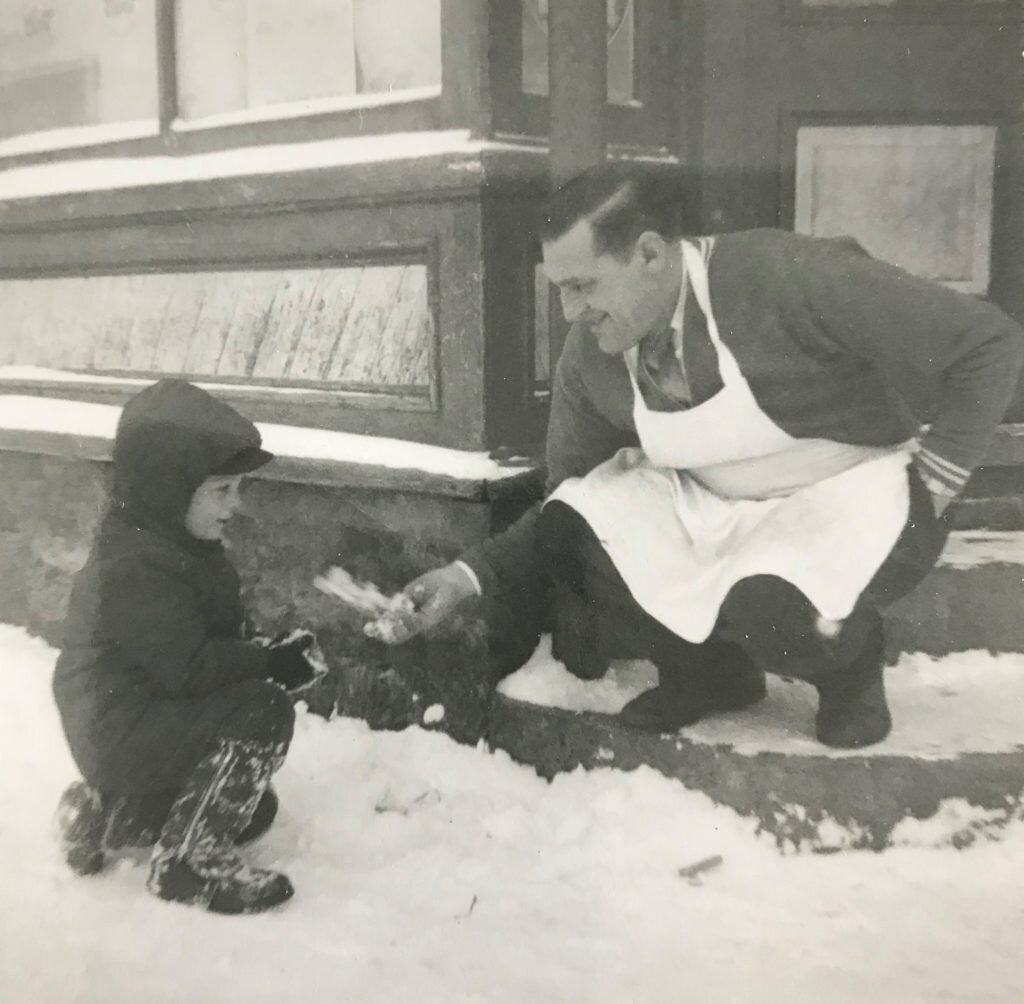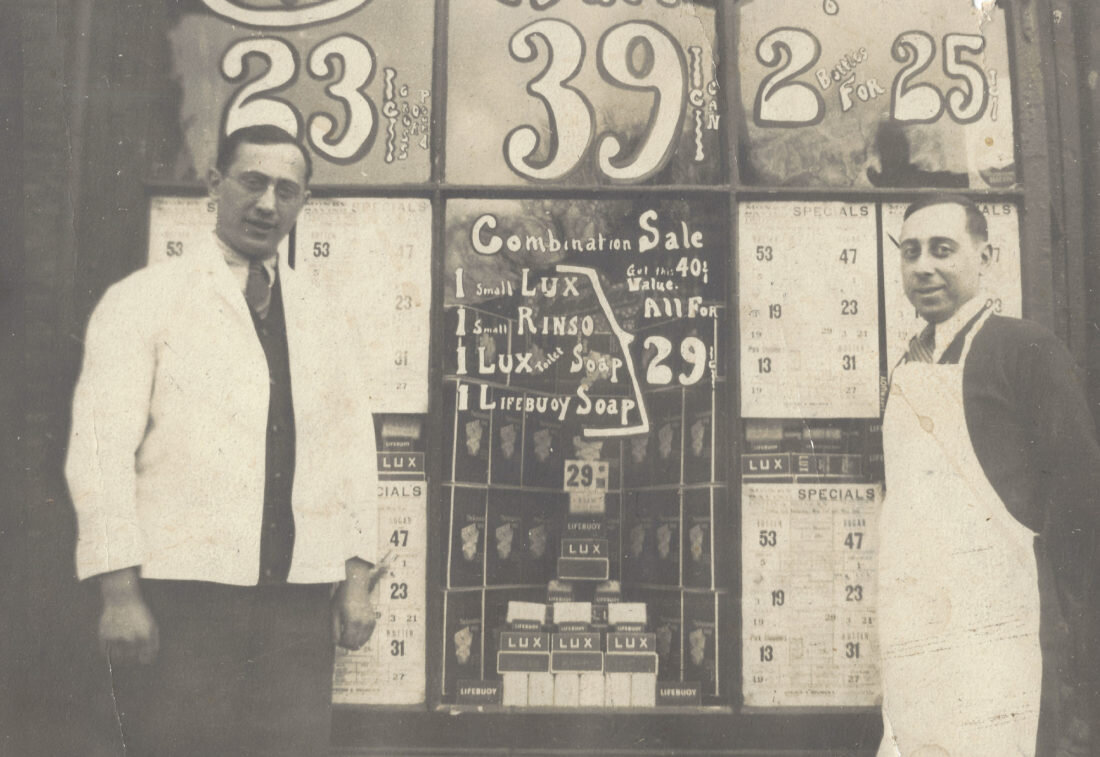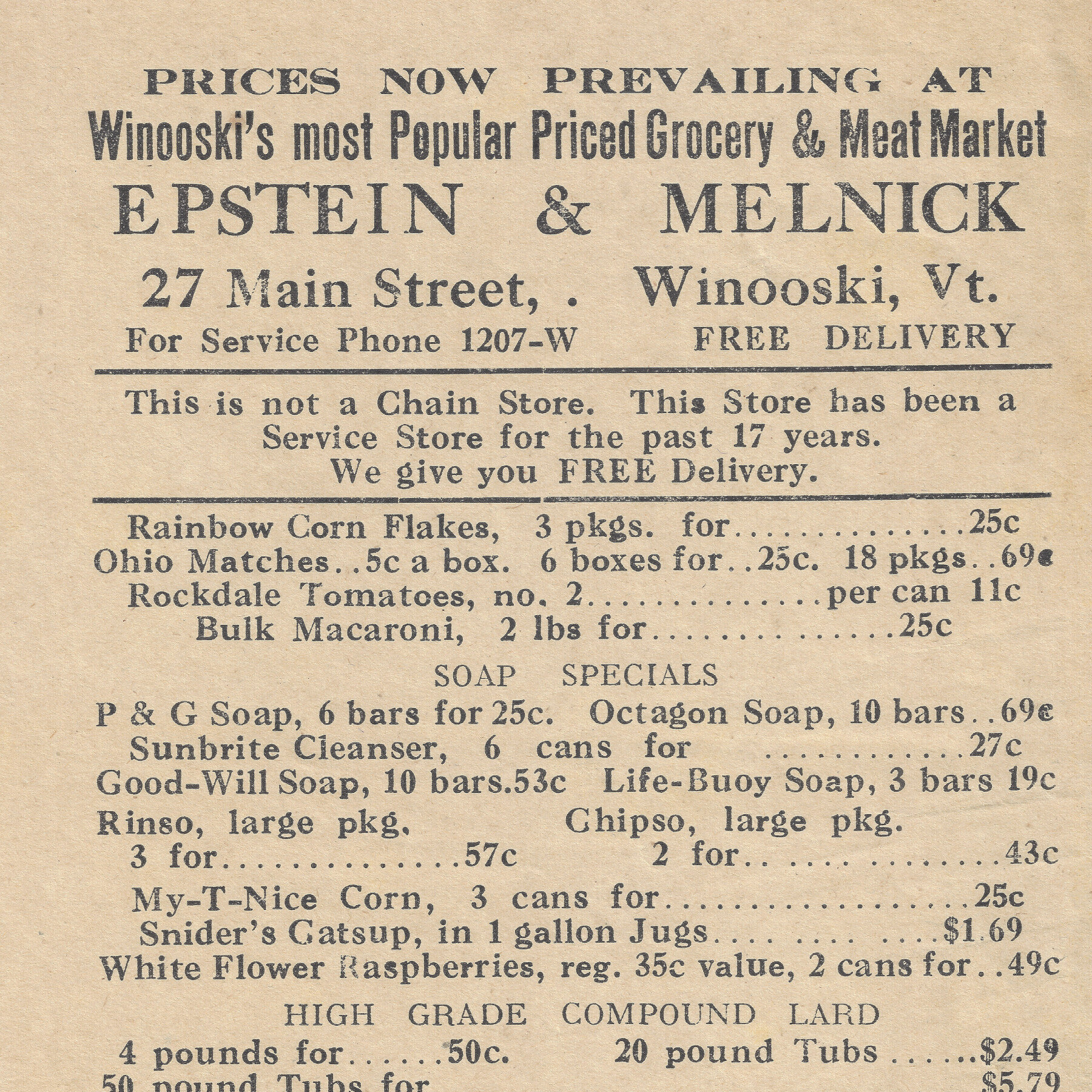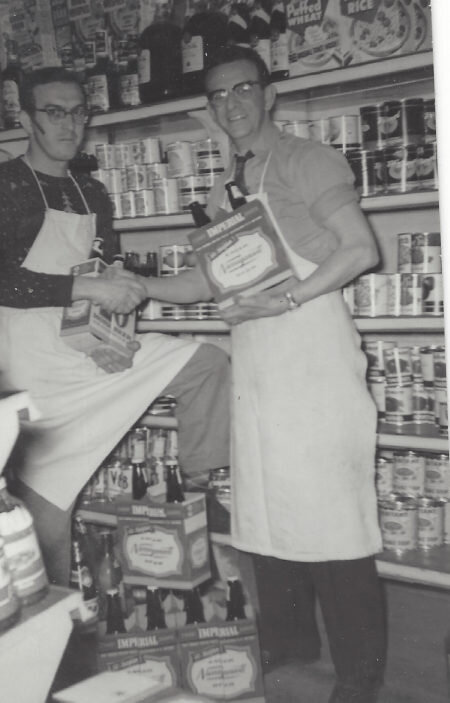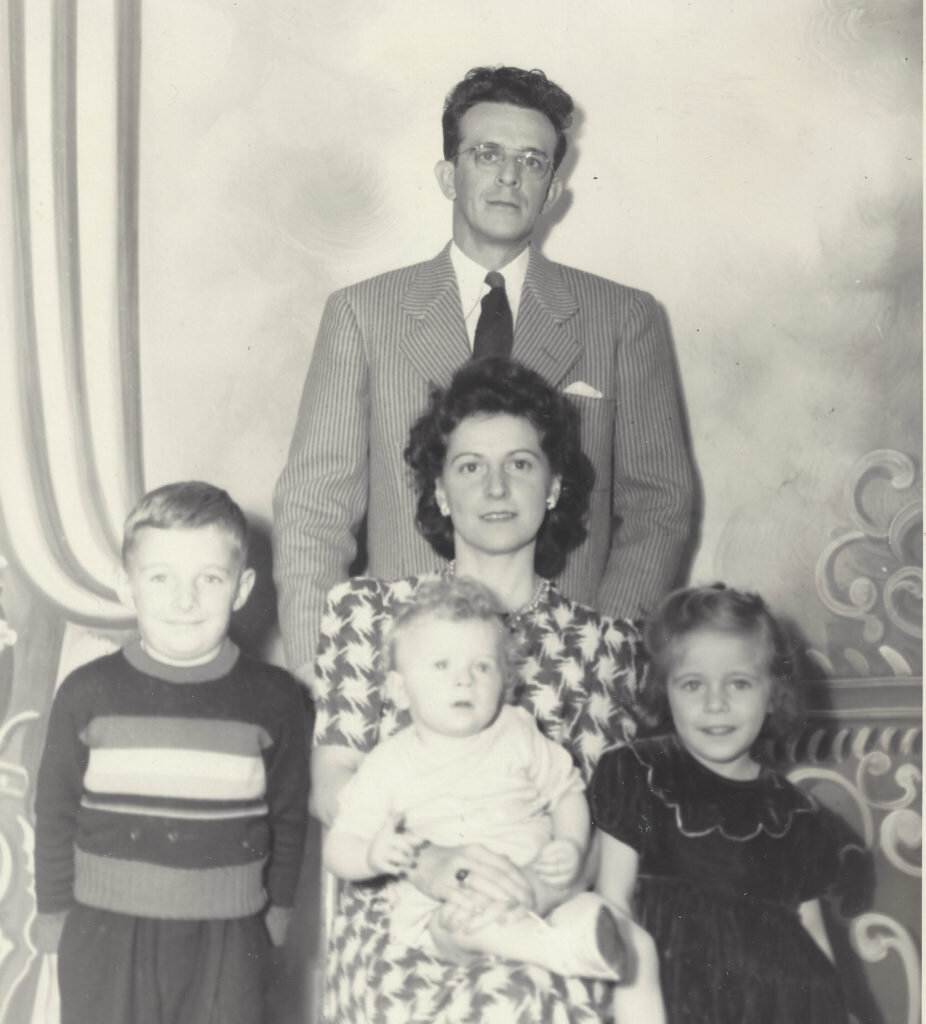Finding Community in Local Markets of Burlington and Winooski, Vermont
With special permission from Historic New England, The City of Winooski proudly features More than a Market, a multi-year project that shares the stories of immigrant-owned markets, past and present, through the voices of their owners and customers. Descendants of early market owners and current market owners and their customers share their memories and reflections on how markets connect people to their food traditions, homelands, and communities. The project invites the public to explore the topic in three ways: a web app, a walking tour (fall 2021, summer/fall 2022), and an exhibit, opening in June 2022. The exhibit content will be translated into five languages spoken by local cultural communities. More than a Market is part of Historic New England’s Everyone’s History series, which partners with communities to collect, preserve, and share diverse stories of life in New England through documentary films, exhibitions, books, and public programs. To view the originally sourced content below and to learn more, please visit morethanamarket.org. For more information about the project, contact: Charlotte Barrett, cbarrett@HistoricNewEngland.org, 802 989 4723.
“For almost 200 years, local markets have been a ‘home away from home’ for many people. In cities and towns with a rich immigrant history, markets were many things—a family business, a community gathering place, and a purveyor of food. These markets were a source of emotional and physical nourishment, woven into the daily lives of residents. Here customers could socialize, catch up on local and national news and hear gossip from back home, speak in a native language, and purchase familiar foods … Immigrant families owned many of these markets and usually lived upstairs or nearby in order to serve customers while still involved in family life. They worked long hours, yet had the time to lend an ear or a helping hand to neighbors. The arrival of chain supermarkets in the 1940s triggered a decline in small markets. Early arrivals like IGA or First National opened in the neighborhoods and thus remained part of the fabric of the community. By the 1950s many supermarkets opened in the outskirts, where large tracts of land allowed for sprawling buildings and parking lots. While small markets could not compete with the vast selection at supermarkets, they offered something else—personal service, social connection, and the specialty foods that reminded people of their heritage and culture … Since the 1980s, immigrants from Vietnam, Bosnia, Bhutan, and Eastern and Western Africa have carried on this entrepreneurial tradition—some in the same neighborhoods, or even buildings, others in outlying suburbs where new Americans have settled … Today, we may find community in many places between work and home—coffee shops, library reading rooms, bookstores, community centers, religious meeting spaces, community gardens—and local markets. Like community living rooms, these places offer us a place to relax, share ideas, and satisfy a universal longing for connection. Where do you go to connect with others in your community?”
Chick’s Market
A French-Canadian Market at 60 Hickok Street In Winooski: 1944 - Present
Chick’s Market was the place people came for “a smile and a story” and the best grinders in town. Edmund G. “Chick” Dupont moved seamlessly between the carefree world of children and the more serious world of local and state politics. As mayor of Winooski from 1963 to 1969, Chick juggled customer and constituent care from behind the cash register. Chick Dupont’s father, Napoleon, and mother, Alice, emigrated from St. Armand East, Quebec, to Vermont in 1905, and settled in Winooski, by then a well-established, predominantly French Canadian mill town. Born in 1920, Chick left school after the eighth grade to help support the family as a weaver at the American Woolen Mill. In 1941 he married Winooski native Florence Granger.
The kids on the street would run into the store and grab a piece of penny candy and run back out again. Chick would pretend to chase them, but it was just a game. The kids would laugh as they ran out the door. — Carolyn Dupont Steinmetz, Chick Dupont’s second cousin
Chick with nephews Dick and Tom Corbiere (left to right), who worked at the store as teenagers. Chick knew neighborhood kids by name.
Chick with friends, c. 1944
By 1940 Chick was clerking for Ralph G. Lafrance, who owned a market on Mallet’s Bay Avenue. In 1944 he opened his own market at 13 West Center Street and, one year later, relocated to 60 Hickok Street. From there he presided over the daily comings and goings of residents of “The Flats,” a neighborhood by the mills along the Winooski River, before selling the business to his nephew Richard Corbiere, Jr. in 1982. Today owners Sonny and Pam Vezina call themselves “curators” of this community market. Large in stature and in heart, Chick was beloved by the neighborhood children, joining in their antics and drying tears. Kids played hopscotch and jacks out front and the store served as “home base” for games of hide and seek. Many children stopped by to pick up groceries for their parents and returned home to find penny candy at the bottom of the bag. Timed right, there might be a bologna end for five cents. Chick treated children as if they were the children he and Florence never had. He kept an eye on them while their mothers ran errands and proudly displayed school pictures behind the counter for all to see.
“Lived on west st., right around the corner went there almost every day for my mother, mid 70’s, she give me a note for groceries and smokes, I remember how kind he was to a little boy embarrassed because we didn’t have a lot of money, Chick would keep us in this little book and mom would pay on the first. He would always throw some candy for free in the bag, “don’t tell your mom” it was our little secret, the counter was in the back of the store and I could barely see over it he’d bag the stuff and reach way over to hand it down to me, I thought he was a giant lol. Hey Chick was one of the good ones!” - Tony Barnier, Winooski resident
Chick was honest, pragmatic, and charismatic, qualities that served him well as a businessman and politician. Constrained by long hours at the market, he conducted city and Democratic Party business from the store. All day, he listened to the questions and concerns of his constituent customers. His politics, rooted in the traditional French Canadian values of family, church, and community, emphasized public participation and transparency in government. Sewer and street projects, fire protection, health insurance for city employees—Chick tended to the typical business of small city government. In his last term as mayor in the late 1960s, he was instrumental in the inclusion of Winooski in the Model Cities Program, which funneled federal funds to the city for social programs and renewal of deteriorating neighborhood buildings and infrastructure.
“He worked hard to improve the city and make it a family friendly place. He always listened to what people had to say and he tried to incorporate good ideas. There were always men gathered at the oil stove in the store talking, sharing stories and talking politics. All opinions were welcome.” - Craig Soutiere, Winooski resident
Epstein & Melnick Market
A Jewish Market At 27 Main Street In Winooski: 1910-1973
Mayer Epstein (center) and Sam Melnick (right) with Sam and Sophia Epstein. Photo courtesy of Merrill Epstein.
Countless Jewish-owned businesses operated in the Old Jerusalem neighborhood of Burlington, but Mayer H. Epstein and Samuel Z. Melnick set their sights across the river in Winooski, where only a handful of Jewish families lived. They established a thriving market that served the community for sixty-three years, before the building became a casualty of urban renewal. By then the Epstein family had been operating the market on its own for twenty-five years.
Mayer and Minnie Melnick Epstein, and their son Louis, emigrated from Ivye, Russia (today, Iwye, Belarus), to the United States around 1900, perhaps to escape the growing unrest and repression of Jewish culture that precipitated the first Russian Revolution in 1905. They joined the Epstein family in Mount Pleasant, Pennsylvania, before moving to Burlington, where Minnie’s brother Samuel Melnick lived. The Jewish community was closely intertwined in those days; marriages frequently occurred between families from the same shtetls, or villages, in Eastern Europe. Mayer came from a distinguished family of rabbis, but had chosen groceries as his livelihood in Ivye. He took a job as a clerk at Saiger’s Grocery and Department Store at 87-95 North Avenue and the family lived in an apartment above the store.
Left to right: Mayer H. Epstein (behind counter), son Sam Epstein (end of counter), partner Sam Melnick (center of store). Photo courtesy of Merrill Epstein
Left to right: Sophia Epstein, Sam Epstein, Sam Melnick, Mayer Epstein, Jim Smith (employee). Photo courtesy of Merrill Epstein.
John (left) and Sam (right) Epstein. Photo courtesy of Merrill Epstein.
When the Saiger family opened a second store on Mallet’s Bay Avenue in Winooski in 1908, Mayer and Sam managed the store. After the Saigers withdrew, Mayer and Sam continued to operate there as the People’s Bargain Store. In 1910, they moved to 27 Main Street and reopened as Epstein & Melnick. All five Epstein children—Louis, Sam, John, Eva, and Sophia—worked at the store and lived in the apartment upstairs off and on until the store closed. Mayer and Minnie’s grandchildren Merrill and Judy fondly recall spending Sunday afternoons in the apartment upstairs with their aunts while their father, Sam, did inventory. It was a cozy place where the family celebrated Passover each year, since it was an easy climb upstairs to begin the evening Seder. When Sam was done with the weekly accounting, the family would go on picnics at Ethan Allen Park or for a drive in the country. In 1939, Sam Melnick left the business and Mayer handed over management of the store to his sons Sam and John. By then, eldest son, Louis, had opened Lake View Market (1933-1963) on Shelburne Street in Burlington. The daughters had specific jobs—Eva cut and packaged the meat and Sophia delivered to customers and picked up inventory from suppliers like McKenzie’s Meats and Champlain Fruit Company in Burlington. By the 1940s, the shift to self-serve reconfigured the central open space into aisles of canned and dry goods. The store sold fresh, local produce, with “the corn you’ve been waiting for” a highlight. The store carried very few kosher items, a reflection of the small Jewish community in Winooski. For special Passover items for themselves, the Epsteins shopped at Blumenthal’s Market in Burlington. Though observant Jews, they opened the market on the Sabbath—unlike many of the Little Jerusalem markets—but closed on the major Jewish holidays. As the nature of the grocery business evolved, Epstein & Melnick adapted to remain competitive. Free delivery, the addition of a meat counter, the installation of an illuminated gas pump out front for “autoists,” and entertaining ads scripted by John helped to retain the customer base.
The Epstein brothers co-owned a successful business, but their personalities were very different. Where John was gregarious with a flamboyant sense of humor, Sam was quiet with a dry wit. John performed in countless variety shows and plays to raise money for local organizations—singing, dancing, and serving as “end man.” His creative ads in the Burlington Daily News attracted attention from Food Topics, a national newspaper for retail grocers. John attributed the market’s robust sales to his “personal touch” advertising combined with the emphasis on special savings. The ads typically began with a personal note to customers or a whimsical anecdote, sometimes mentioning customers or family by name. John spent three or four hours each week at the newspaper advertising office designing his ad. He also used the ads to promote local causes like voting or the PTA. Sam was just as likely to spend an evening composing a Letter to the Editor in the evening, sharing his knowledge of history and culture or commenting on a news article or opinion. He took delight in puzzles of all kinds – acrostics, palindromes, and other brainteasers. His son, Merrill, recalls that for every president elected, he would do an acrostic with the name of the president in it and send it to the White House. He usually received a response. “Sam always had a pencil resting on his ear and he wore the same little Irish hat every day. If your bill came to 4.44, he’d say it’s the same amount backwards. - Jeff Rawding, Winooski customer
Roy's Market
A French-Canadian Market At 126 Weaver Street In Winooski: 1923 - 1967
Edward Roy (right) with Frank Mavalinskas. Photo courtesy of Monica Roy.
Edward Roy (foreground) with son Maurice. Photo courtesy of Monica Roy
Photo courtesy of Larry Emile Roy.
Protecting the welfare of the community was a Roy family value. During the 1918 flu pandemic, with Winooski under quarantine and many residents sick, Edward Roy’s daily milk deliveries were a lifeline to the community—and not only for nourishment. Customers confined to their homes left prescriptions in their empty milk bottles, which he filled at the drug store and returned in the afternoon. Born in Iberville, Quebec, in 1883, Edward was one of five children of Gilbert and Delina Roy, farmers who immigrated to Vermont in 1885. Gilbert became a boot and shoe maker, and when the children were old enough, they took jobs in the mills. Their house at 2 North Street was a large, multi-generational home. Edward Roy’s first business venture as a milk dealer was a grueling seven-day-a-week job. Farmers from Essex and Colchester, Vermont, delivered cans of milk by 3:00 a.m. Edward and his wife, Laura, would bottle and cap three hundred bottles of milk and cream to deliver to households by 6:00 a.m. Because the milk was not pasteurized and refrigeration was unavailable, it required daily delivery to stay fresh. Their horse, Old Molly, who knew the route by heart, pulled a wagon in summer and a sled in winter through Winooski and the eastern neighborhoods of Burlington. Like many immigrants, Edward juggled several jobs to support Laura and their seven children. At various times between 1903 and 1923, he was a weaver at the American Woolen Mill, a clerk at a local market, and a milk dealer. Edward and Laura purchased the Weaver Street market in 1923 and raised their family in the rooms behind the store and upstairs. As he grew older, Edward was happy to leave management of the store to his children and spend his time fishing—often with grandchildren in tow.
Delivering milk to city homes, c. 1925. Courtesy of Library of Congress.
Burlington Free Press, May 25, 1921
When Edward died in 1954, three of his seven children—Emile, Irene, and Bernard—shared management. Emile was the meat cutter; Bernard handled deliveries and advertising; and Irene clerked and did the books. The family continued to live in the building. Roy’s Market was a hub of activity. Customers chatting, the screen door slamming, and the thick, wooden cooler door thudding—all reverberated in the family’s apartments. IBM managers, mailmen, the mayor, the police chief, the school principal, mill workers, teachers, and the monsignor from church mingled in the market. Emile’s son, Larry, loved hanging out at the market with his cousin Paul, helping his dad and acting as audience for customers and deliverymen who visited with his dad and dispensed advice to the boys. Roy’s Market was a hub of activity. Customers chatting, the screen door slamming, and the thick, wooden cooler door thudding—all reverberated in the family’s apartments. IBM managers, mailmen, the mayor, the police chief, the school principal, mill workers, teachers, and the monsignor from church mingled in the market. Emile’s son, Larry, loved hanging out at the market with his cousin Paul, helping his dad and acting as audience for customers and deliverymen who visited with his dad and dispensed advice to the boys.
Family photos courtesy of Larry Emile Roy unless otherwise indicated.
Bernard (left) and Emile (right) Roy
Emile and Rita Santerre Roy with their children (left to right) Larry, Camille, and Anne.
Watch: The Hum of Market Life
Watch: A Language Lesson - Well into the 1950s, French was widely spoken in Winooski—at church and school, in stores and homes. It could be a challenge for young people like Larry Roy to speak two languages fluently.
Watch: Feeding the Community - Edward’s son Emile, who managed the store after his father retired, continued the tradition of community service. Like many markets, Roy’s extended credit and often forgave debts. The family prepared and distributed gift baskets at Christmas and donated food where they saw a need.
More Than A Market tells the stories of new American-owned markets in Burlington and Winooski through the voices of their owners and customers. The project is underway now, with a walking tour launching in September 2021 and an exhibit in June 2022. Who’s working on this project? Historic New England (@historicnewengland) with partners AALV (@aalv_inc), The Vermont Folklife Center, Burlington Edible History, the Winooski Historical Society, and market owners. The stories of these current markets will be shared through interviews with market owners and through contributions of photos, comments, and stories from market customers and community members. Tag #mtamvt to contribute, or find us on Facebook (@HistoricNewEnglandVT) at the contact info in bio, or in the markets!
Visit the project website www.morethanamarket.org for stories of past markets, shared through archival photos and interviews with descendants of the past market owners.





